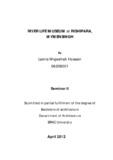River life museum at Rishipara, Mymensingh

View/Open
Date
2012-04Publisher
BRAC UniversityAuthor
Hossain, Lamia WajeehahMetadata
Show full item recordAbstract
Bangladesh, a riverine deltaic country consists of about 800 rivers. Most of the land
area of the country had formed through the silt brought by the mighty rivers. The rivers
overflow, causing floods on its banks during the monsoon seasons, often causing havoc.
Simultaneously the floods bring in fertile land making Bangladesh a country of alluvial
soil, which shapes our country into an agrarian society. Along with the floods, river
erosion is another calamity. However together with the floods, erosion and all the
others gifts of silt, fertile land, scope of cultivation, the rivers are highly intertwined with
the lives of the people of Bangladesh. Civilizations, human settlement, trade, religion
and culture all spread through out the country along these innumerable waterways.
Together with the lush green shades of paddy fields , the flowing water channels form
the picturesque landscape of the country.
A river life museum had been proposed not only to serve as a space of public realm,
but also make the visitors realize the contributions of the rivers to human life and also
often how our mis-use has hindered the river systems which eventually effects us
through environmental hazards. This could act as an awareness scheme towards saving
the rivers of Bangladesh.
The paper was written as an explanation of my thesis project, the river life museum. The
paper includes the various process undergone for the completion of the project. The
reason behind the selection of the project , its particular site, the site analysis were
discussed in this paper. Literature studied for the project, case studies of similar
museum projects, and the derivation of the final program were covered. This also
includes the different development phase of the design process.
